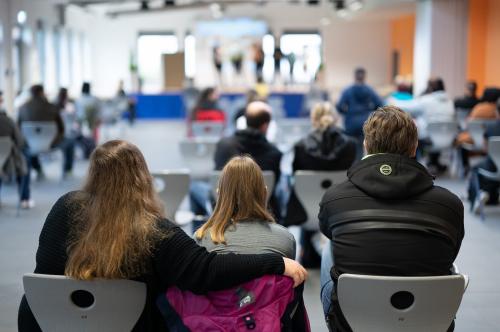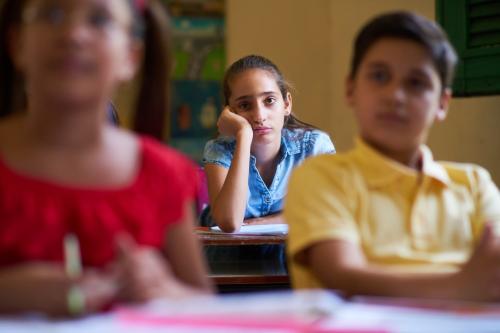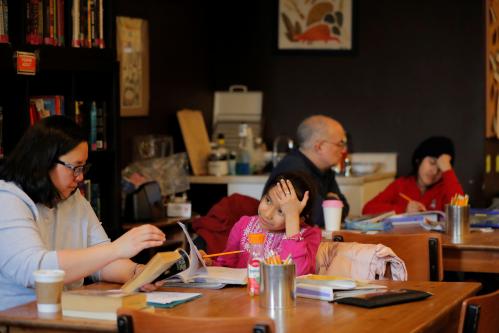Since March 2020, economists have warned of potential long-term losses in economic productivity and opportunity that could result from extended school closures. The World Bank predicted that the lifetime incomes of school children at the time could decline as much as $17 trillion worldwide, and significantly increase the share of families living in poverty.
In the U.S., where schools stayed closed longer than in most developed countries, the pandemic wiped out the progress made in student learning since 1980, new national test scores show. National Assessment of Educational Progress results from late 2022 show the largest declines ever recorded in fourth- and eighth-grade math, and reading scores that have regressed to levels not seen for two decades. Low-income and minority children lost the most instruction during the pandemic, their scores dropped the farthest, and gaps between the lowest- and highest-scoring students have widened. This raises the possibility that a smaller number of students will exit the K-12 system prepared to make their own way in the economy.
These urgent academic needs are more worrisome when paired with our latest research findings at the Center on Reinventing Public Education at Arizona State University, which suggests the quality of classroom instruction has declined in districts serving high numbers of disadvantaged students. Top leaders of five school systems we’ve interviewed regularly since 2020, who speak to us candidly in exchange for anonymity, said they’ve made little to no progress carrying out targeted academic recovery efforts. Their instructional focus now, they said, has shifted to tending to gaps in adult skills, which includes re-emphasizing the basics of high-quality teaching and centralizing curriculum materials to keep everyone on track.
In our fourth and final report on these districts’ day-to-day recovery efforts, system leaders said that students with different needs were not actually getting tailored instruction, additional learning time, or high-quality tutoring to backfill their gaps.
“It’s difficult to point to a model classroom at this point,” one top leader told CRPE researchers, after visiting a number of schools.
Teachers’ skills appear to have slipped for a variety of reasons. Educators often had to give up planning and collaboration time to manage staffing shortages. A lack of substitutes prevented teachers from attending trainings on recovery strategies. And an uptick in teacher resignations resulted in a wave of younger and less experienced new hires. District leaders worried that many senior teachers’ skills and focus have eroded and that the newer teachers are far from ideally prepared.
“The pipeline is so much smaller that we’re taking risks and bets on potential teachers that are not always working out,” one school system leader said.
The fact that some districts must shore up teaching before they can effectively help students recover learning comes amid troubling news that third through eighth grade U.S. students are learning at a slower pace than before the pandemic. The results of progress tests taken by 6.7 million children last year and analyzed by assessment company NWEA suggest that the average student needs an additional 4.1 months of instruction to catch up in reading and an additional 4.5 months of instruction to catch up in math.
Of course:
Learning acceleration didn’t happen. Our series of reports on these five school systems shows that when buildings reopened, many pledged to help kids make up for lost learning time via a strategy called acceleration. All students would attend classes taught at grade level, and those who had missed key ideas or skills would get immediate help. Districts first delayed adopting this strategy because of inconsistent student and teacher attendance. Later, many dropped acceleration in favor of strengthening traditional one-teacher, one-classroom instruction. They did this because acceleration requires diagnostic and intervention skills many teachers lack, and districts were unable to provide necessary training. Acceleration also requires more differentiated teacher roles and more minute-to minute adult collaboration than teachers are used to. Districts exhorted teachers to pay attention to differences in kids’ needs and levels of preparation, but they could do little to bring about the changes required for acceleration.
Expectations for students have stayed too low. During the pandemic, most districts and states dropped their testing programs and stopped issuing low grades regardless of student performance. Many also lowered requirements for grade promotion and waived high school graduation requirements, especially for completion of the “hard” math, science, and English courses that hang up many students. Despite many studies documenting serious learning loss and predicting big declines in high school and college success, most parents still think their children are making acceptable academic progress. It’s understandable that educators sought to ease the load on students, but these actions may have made urgent work in school appear to be unnecessary.
School attendance declined and many students disappeared. Though many students attended school as soon as they opened, attendance rates at every level declined. Majorities of children who needed extra learning time did not enroll in new district programs designed to help them recover key skills. Some parents kept children home because they feared COVID-19; some may have feared growing school violence. Some parents that began at least nominal homeschooling haven’t re-enrolled their children in districts; others haven’t been able to get their kids to school regularly.
Schools have resisted changing teacher roles and responsibilities. School districts that have struggled to manage staffing shortages and spikes in teacher resignations are largely ignoring ways to make teaching more attractive. A recent CRPE study shows that districts often focus on recruiting more teachers, instead of on improving working conditions to make the job more attractive. Schools should experiment with workforce redesigns such as teaching in teams, hiring subject matter specialists from other fields, creating personalized instruction roles for teachers, and offering more pay for specialized skills in math, science, and special education. Those strategies are rarely on the table as districts negotiate with unions over changes in pay and class size. “We spent a lot of money on retention bonuses and ‘please stay’ payments,” one system leader told our researchers. “You might as well burn that money because it didn’t bear out. People left anyway.”’
Political controversies have distracted school leaders. Political disputes over how schools handle cultural issues related to race and LGBTQ+ concerns have disrupted teaching and learning, leading to spikes in discriminatory incidents and also declines in achievement, new studies show. Conservatives have threatened educators and inundated school offices with public information requests, while progressives have pressed for “dismantling white supremacy” in mathematics. The time administrators have spent managing adult concerns helped propel the current teaching crisis because it distracted them from the normal business of helping teachers assess student progress, differentiate their instruction, and rally behind a vision for student success.
After the stresses of the pandemic, a desire for normalcy is understandable. But school and district leaders need to shout louder about the needs of students and staff. And policymakers, community leaders, parents, businesses, and philanthropists need to listen and collectively figure out solutions without picking partisan and ideological fights about them. The experiences of these districts align with other new research that suggests the influx of federal pandemic school aid (most of which has already been spent or allocated) has not been sufficient to cement the kind of large-scale recovery programs necessary to address the magnitude of learning loss. States, districts, and communities must consider new ways to help students still tracking significantly behind. They could explore other avenues for extending tutoring efforts. And they could better engage historically marginalized parents in the search for solutions to best help support traditionally disadvantaged Black and brown students who, as NWEA describes, “remain furthest from recovery.”
The short-term consequences of doing nothing for students most in need are easy for many people to dismiss. But passing through an entire cohort of young people with very large gaps in academic knowledge and vastly under-developed emotional skills would be a mistake.
The moral, economic, and social consequences of that much lost adult potential have yet to be tested. We urge communities to collaborate and find solutions that would avoid making that gamble.
The Brookings Institution is committed to quality, independence, and impact.
We are supported by a diverse array of funders. In line with our values and policies, each Brookings publication represents the sole views of its author(s).








Commentary
Accepting lost learning today will have big costs later
July 21, 2023